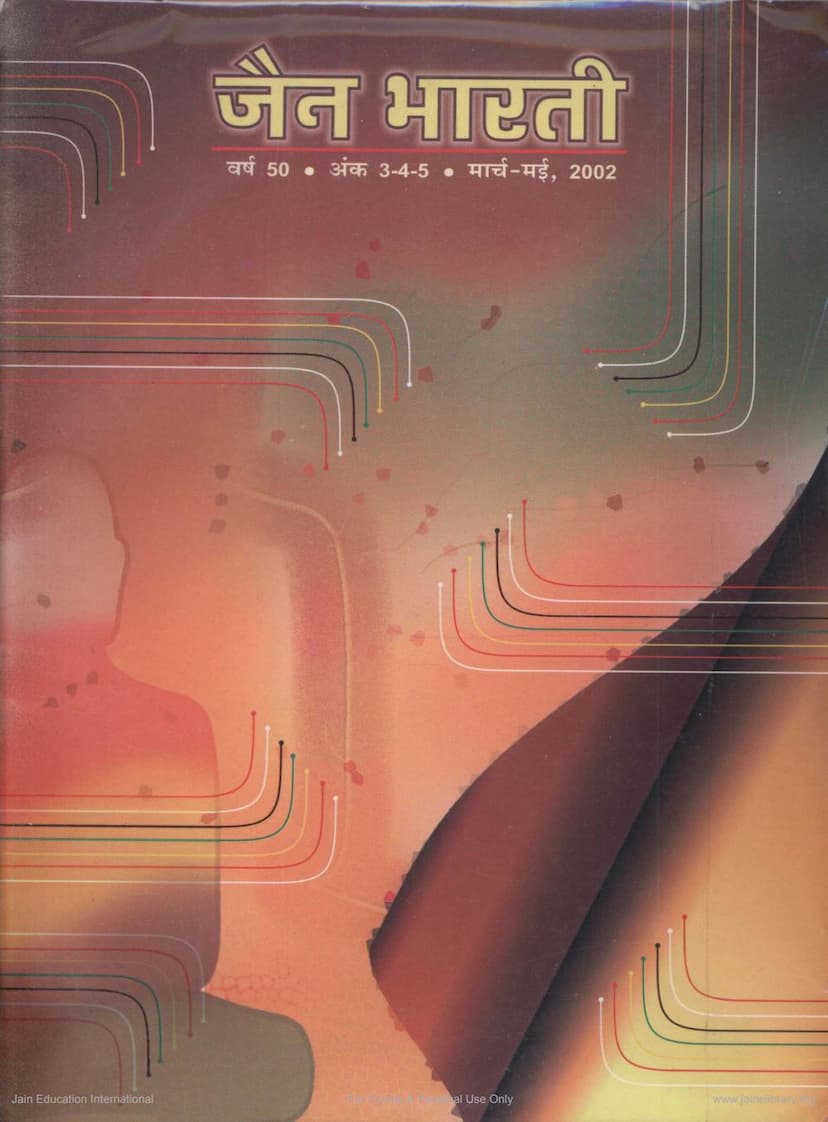Jain Bharti 3 4 5 2002
Added to library: September 1, 2025

Summary
Here's a comprehensive summary of the Jain text "Jain Bharti 3 4 5 2002," focusing on its core themes and contributions:
Overall Theme: The Relevance and Application of Anekantavada in Modern Times
This issue of Jain Bharti is dedicated to Anekantavada, a foundational principle of Jain philosophy. It explores its origins, development, and, most importantly, its profound relevance and practical application in navigating the complex challenges of the modern world. The articles collectively argue that Anekantavada offers a sophisticated framework for understanding diverse perspectives, fostering tolerance, and promoting peaceful coexistence, not just in philosophical discourse but in every sphere of life – personal, social, political, and economic.
Key Concepts and Themes:
- Anekantavada as a Universal Principle: While rooted in Jainism, the articles highlight that Anekantavada, with its emphasis on multiple viewpoints and the relativity of truth, is not confined to a religious or philosophical dogma. It is presented as a universally applicable methodology for understanding reality and resolving conflicts.
- Critique of Ekantavada (One-Sidedness): The issue consistently contrasts Anekantavada with Ekantavada (one-sidedness or absolutism). Ekantavada is identified as the root cause of intolerance, conflict, and dogmatism in various fields, from religion and philosophy to politics and personal interactions.
- The Interconnectedness of Anekantavada, Syadvada, and Nayavada: Several articles emphasize that these three concepts are intrinsically linked and form the bedrock of Jain epistemology. Nayavada (theory of perspectives) explains how different viewpoints arise, Syadvada (the theory of conditional predication) provides the linguistic and logical framework to express these multiple perspectives, and Anekantavada is the underlying metaphysical principle that validates the existence of these multiple realities.
- Anekantavada as a Method of Conflict Resolution: A significant portion of the content is dedicated to demonstrating how Anekantavada can be applied to resolve conflicts. This includes understanding differing viewpoints, practicing intellectual non-violence, and fostering a spirit of tolerance and respect for disagreement.
- Anekantavada in Society and Politics: The articles explore the application of Anekantavada in understanding social structures, political ideologies (like democracy, capitalism, communism), and interpersonal relationships. It's presented as a tool to bridge divides, promote dialogue, and build cohesive societies.
- Anekantavada and Spiritual Revival: Several pieces connect the principles of Anekantavada to the need for spiritual revival in the face of modern societal ills like materialism, inequality, and conflict. It's argued that a spiritual awakening, informed by Anekantavada, is essential for addressing these issues.
- Anekantavada in Scientific and Philosophical Discourse: The issue delves into the philosophical underpinnings of Anekantavada, comparing its concepts to Western philosophical ideas (like Aristotle's views on form and matter, or the concept of relativity in physics) and highlighting the shared pursuit of understanding a multifaceted reality.
- The Practical Application of Anekantavada: Beyond theoretical discussions, many articles focus on the practical application of Anekantavada in daily life, emphasizing the importance of understanding others' perspectives, practicing tolerance, and adopting a non-dogmatic approach to beliefs and actions. The story of the blind men and the elephant is a recurring example of the limitations of one-sided perception.
- The Role of Nayavada: The nuances of Nayavada, explaining how different perspectives (nayas) lead to partial but valid understandings of reality, are explored, underscoring the importance of recognizing the validity of multiple viewpoints.
- Anekantavada as a Foundation for Harmony and Coexistence: The overarching message is that embracing Anekantavada fosters harmony, mutual respect, and peaceful coexistence by acknowledging the validity of multiple perspectives and working towards their reconciliation.
Key Contributors and Their Focus:
- Acharya Shri Mahapragya: Focuses on Anekantavada as the basis for constructing a new society and its role in fostering understanding and tolerance between differing viewpoints. He links it to the concepts of aparigraha and the necessity of samayikta (relativity).
- Prof. Dayakrishna: Raises critical questions about the practical application of Anekantavada, particularly regarding its potential for circularity and the challenge of reconciling seemingly contradictory truths.
- Dr. Bachhraj Dugad: Discusses the practical viability of Anekantavada in scientific progress, personal development, and societal harmony, emphasizing the need for a balanced approach.
- Dr. Ramji Singh: Connects Anekantavada to the spiritual quest and the limitations of human perception, highlighting its role in overcoming ego and achieving holistic understanding.
- Dr. Anil Dhar: Explores the scientific and philosophical underpinnings of Anekantavada, linking it to concepts of relativity and the multifaceted nature of reality.
- Prof. Sagarmal Jain: Presents Anekantavada as a practical method for seeking truth, emphasizing its role in synthesizing diverse philosophical viewpoints and resolving conflicts through moderation.
- Dr. Phoolchand Jain Premi: Highlights the relevance of Nayavada and Anekantavada for modern times, positioning them as Jainism's unique contribution to understanding truth and resolving disputes.
- Dr. Harishankar Pandey: Examines the presence of Anekantavada in Vedic literature, particularly in linguistic interpretations and the acknowledgement of multiple attributes within a single entity.
- Dr. Anandprakash Tripathi: Analyzes the relationship between Anekantavada and the philosophy of Aristotle, noting parallels in their emphasis on multiple perspectives and the rejection of absolute, one-sided truths.
- Dr. J.P.N. Mishra: Draws parallels between the intricate and balanced functioning of the human body and the principles of Anekantavada, showcasing how opposing forces maintain harmony.
- Yuvacharya Mahashraman: Focuses on the practical application of Anekantavada in daily life, emphasizing the importance of non-attachment and the dangers of dogmatism, illustrated through a compelling story.
- Sadhvipramukha Kanakprabha: Uses the metaphor of a bridge to describe Anekantavada's role in connecting differing viewpoints and fostering understanding.
- Neeraj Jain: Presents Anekantavada as the ultimate eye of contemplation.
Conclusion:
The issue of Jain Bharti is a rich repository of thought on Anekantavada. It positions this Jain philosophical principle not as an archaic doctrine but as a vital and relevant framework for addressing contemporary issues. By advocating for a nuanced understanding of truth, a respectful approach to differing opinions, and a commitment to harmonious coexistence, the articles collectively call for the integration of Anekantavada into all aspects of individual and collective life.